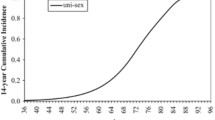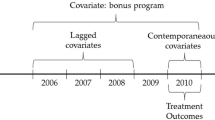Abstract
We use a structural approach to separately estimate moral hazard and adverse selection effects in health care utilization using hospital invoices data. Our model explicitly accounts for the heterogeneity in the non-insurable transactions costs associated with hospital visits which increase the individuals’ total cost of health care and dampen the moral hazard effect. A measure of moral hazard is derived as the difference between the observed and the counterfactual health care consumption. In the population of patients with non life-threatening diagnoses, our results indicate statistically significant and economically meaningful moral hazard. We also test for the presence of adverse selection by investigating whether patients with different health status sort themselves into different health insurance plans. Adverse selection is confirmed in the data because patients with estimated worse health tend to buy the insurance coverage and patients with estimated better health choose not to buy the insurance coverage.


Similar content being viewed by others
Notes
It appears that the Croatian system does not precisely distinguish co-payments from co-insurance in the sense of the first being the flat fee and the second being the percentage of the cost. The term actually used in English translation means “participation.” However, the distinction is immaterial because prices of medical services (payments that providers receive from the HZZO) are fixed by HZZO and do not vary by provider and are also fixed for the period covered by our data.
Listed co-payments were valid for 2009. The exchange rate for the local currency, Croatian Kuna (HRK), as of June 20, 2009 was 1 USD = 5.19 HRK.
The actual name of the county is suppressed for confidentiality reason because revealing the name of the county would automatically reveal the name of the hospital.
We assume the required amount of time per visit is the same for all patients. This assumption is reasonable because the region from which the hospital draws its patients is rather small so the travel time to reach the hospital should not vary a lot across patients. Secondly, unlike for big hospitals in large cities, the facilities utilization of regional hospitals in Croatia is low, so the waiting time is likely to be equally short regardless of the required procedure.
Here, it is important to realize that even without the supplemental insurance, the patient will almost never pay the full cost of the medical service, because some portion of it is always paid by the universal (compulsory) insurance.
Bajari et al. (2014) used the same approach. However they have 3 years worth of data and they assume that \(\theta \) distribution does not change from 1 year to the next.
The results are comparable to the results obtained by Bajari et al. (2014) who also found that the risk aversion parameter for health care consumption is larger than that of the general consumption. Their estimates of \(\gamma _{1}\) are in the range of [1.88,1.98] and the estimates of \(\gamma _{2}\) are in the range of [3.12, 3.27].
This percentage represents the average of individual co-payment rates, whereas the ratio of two means (co-payment per patient of 77.42 HRK and cost per patient of 257.11 HRK) for the No group in Table 1 is only 30%.
The patients in the Free group are not used in this experiment because of the data coding problem. In many instances the entire cost of the visit has been charged to the compulsory insurance and zero to the supplemental insurance. Hence, when losing the insurance the patient in the Free group is now required to pay certain percentage of the cost as a co-payment, but any percent of zero is still zero. Notice, however, that this data coding problem does not affect the estimation for \(\hat{\gamma _{1} },\hat{\gamma _{2}}\), \({\hat{t}}\) because for estimation purposes we only need total cost per patient rather than a part covered by compulsory and a part covered by the supplemental insurance.
Fang et al. (2008) found evidence of advantageous selection in the Medigap insurance market and suggested that the sources of this advantageous selection include the insureds’ income, education, longevity expectations, financial planning horizons and especially the cognitive ability.
References
Bajari, P., Hong, H., Khwaja, A., & Marsh, C. (2014). Moral Hazard, adverse selection and health expenditures: A semiparametric analysis. The Rand Journal of Economics, 45(4), 747–763.
Cameron, A. C., Trivedi, P. K., Milne, F., & Piggott, J. (1988). A microeconometric model of the demand for health care and health insurance in Australia. The Review of Economic Studies, 55(1), 85–106.
Cardon, J. H., & Hendel, I. (2001). Asymmetric information in health insurance: Evidence from the national medical expenditure survey. The RAND Journal of Economics, 32(3), 408–427.
Cutler, D., & Zeckhauser, R. (2000). The anatomy of health insurance. In A. J. Culyer & J. P. Newhouse (Eds.), Handbook of health economics (Vol. 1A, pp. 563–644). Amsterdam: North Holland.
Einav, L., Finkelstain, A., Ryan, S. P., Schrimpf, P., & Cullen, M. R. (2013). Selection on Moral Hazard in health insurance. The American Economic Review, 103(1), 178–219.
Fang, H., Keane, M. P., & Silverman, D. (2008). Sources of advantageous selection: Evidence from the medigap insurance market. Journal of Political Economy, 116(2), 303–350.
Gardiol, L., Geoffard, P.-Y., & Grandchamp, C. (2005). Separating selection and incentive effects in health insurance. CEPR discussion papers No. 5380.
Greene, W. H. (2002). Econometric analysis (5th ed.). New Jersey: Prentice Hall.
Liu, X., Nestic, D., & Vukina, T. (2012). Estimating adverse selection and moral hazard effects with hospital invoices data in a government-controlled healthcare system. Health Economics, 21(8), 883–901.
Manning, W. G., Newhouse, J. P., Duan, N., Keeler, E. B., & Leibowitz, A. (1987). Association health insurance and the demand for medical care: Evidence from a randomized experiment. The American Economic Review, 77(3), 251–277.
Olivella, P., & Vera-Hernandez, M. (2013). Testing for asymmetric information in private health insurance. The Economic Journal, 123(567), 96–130.
Paully, M. (1968). The economics of moral hazard: Comment. The American Economic Review, 58(3), 531–537.
Vera-Hernandez, M. (2003). Structural estimation of a principal-agent model: Moral hazard in medical insurance. The RAND Journal of Economics, 34(4), 670–693.
Wolfe, J. R., & Goddeeris, J. H. (1991). Adverse selection, moral hazard, and wealth effects in the medigap insurance market. Journal of Health Economics, 10(4), 433–459.
Author information
Authors and Affiliations
Corresponding author
Ethics declarations
Conflict of interest
No potential conflicts of interest exist.
Rights and permissions
About this article
Cite this article
Zheng, Y., Vukina, T. & Zheng, X. Estimating asymmetric information effects in health care with uninsurable costs. Int J Health Econ Manag. 19, 79–98 (2019). https://doi.org/10.1007/s10754-018-9246-z
Received:
Accepted:
Published:
Issue Date:
DOI: https://doi.org/10.1007/s10754-018-9246-z




